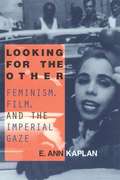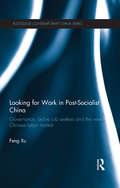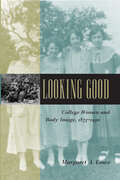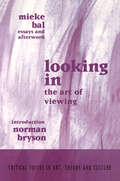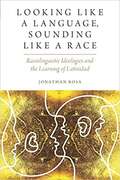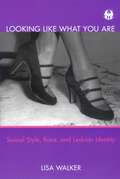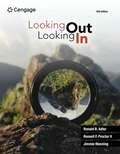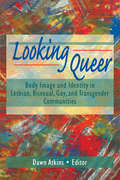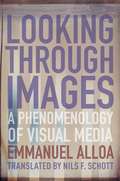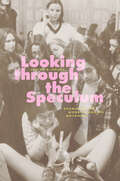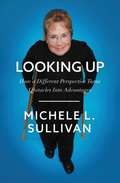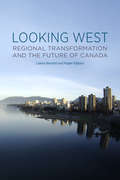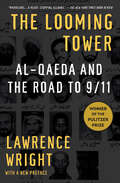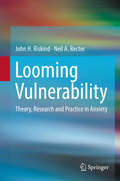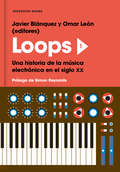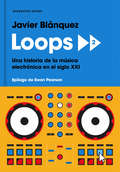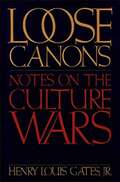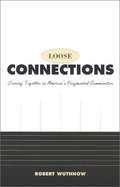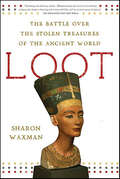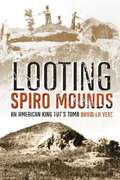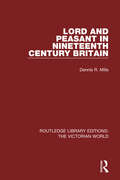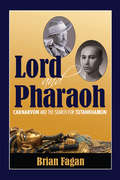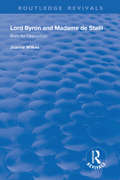- Table View
- List View
Looking for the Other: Feminism, Film and the Imperial Gaze
by E. Ann KaplanWhat happens when white people look at non-whites? What happens when the gaze is returned? Looking for the Other responds to criticisms leveled at white feminist film theory of the 1970s and 1980s for its neglect of issues to do with race. It focuses attention on the male gaze across cultures, as illustrated by women filmmakers of color whose films deal with travel. Looking relations are determined by history, tradition, myth; by national identity, power hierarchies, politics, economics, geographical and other environment. Travel implicitly involves looking at, and looking relations with, peoples different from oneself. Featured films include Birth of a Nation, The Cat People, Home of the Brave, Black Narcissus, Chocolat, and Warrior Marks. Featured filmmakers include D.W.Griffith, Jacques Tourneur, Michael Powell, Julie Dash, Pratibha Parmar, Trinh T. Min-ha, and Claire Denis.
Looking for Work in Post-Socialist China: Governance, Active Job Seekers and the New Chinese Labour Market (Routledge Contemporary China Series)
by Feng XuUnemployment is one of the most politically explosive issues in China and has gained further prominence as a result of the present global financial crisis. The novelty, urgency, and complexity of Chinese unemployment have compelled the government to experiment with policy initiatives that originate in the West. This book argues that although China is not a liberal democracy, it has turned to neo-liberal forms of governance to deal with unemployment, which now function alongside pre-existing Chinese modes of governance. This book examines the initiatives which represent China’s attempt to institutionalize and humanize its approach to governance: these initiatives include training programmes; counselling; a web-based national labour-market information network; insurance; and using community (shequ) organizations as the base for new mechanisms of governance and informal job generation. Based on extensive original research including semi-structured interviews, the book discusses the ways in which the government combines the new techniques with old campaign-style policy techniques. The author argues that these multiple modes of governance make the state's power visible in the new Chinese labour market, and at the same time run the risk of policy incoherence or even failure.
Looking Good: College Women and Body Image, 1875-1930 (Gender Relations in the American Experience)
by Margaret A. LoweWinner of the Bridgewater State College Class of 1950 Distinguished Faculty Research Award Toward the end of the nineteenth century, as young women began entering college in greater numbers than ever before, physicians and social critics charged that campus life posed grave hazards to the female constitution and women's reproductive health. "A girl could study and learn," Dr. Edward Clarke warned in his widely read 1873 book Sex in Education, "but she could not do all this and retain uninjured health, and a future secure from neuralgia, uterine disease, hysteria, and other derangements of the nervous system." For half a century, ideas such as Dr. Clarke's framed the debate over a woman's place in higher education almost exclusively in terms of her body and her health.For historian Margaret A. Lowe, this obsession offers one of the clearest expressions of the social and cultural meanings given to the female body between 1875 and 1930. At the same time, the "college girl" was a novelty that tested new ideas about feminine beauty, sexuality, and athleticism. In Looking Good, Lowe examines the ways in which college women at three quite different institutions—Cornell University, Smith College, and Spelman College—regarded their own bodies in this period. Contrasting white and black students, single-sex and coeducational schools, secular and religious environments, and Northern and Southern attitudes, Lowe draws on student diaries, letters, and publications; institutional records; and accounts in the popular press to examine the process by which new, twentieth-century ideals of the female body took hold in America.
Looking In: The Art of Viewing (Critical Voices in Art, Theory and Culture)
by Norman Bryson Mieke BalFirst published in 2001. Routledge is an imprint of Taylor & Francis, an informa company.
Looking Like a Language, Sounding Like a Race: Raciolinguistic Ideologies and the Learning of Latinidad (Oxford Studies in Anthropology of Language Series)
by Jonathan RosaLooking like a Language, Sounding like a Race examines the emergence of linguistic and ethnoracial categories in the context of Latinidad. <p><p>The book draws from more than twenty-four months of ethnographic and sociolinguistic fieldwork in a Chicago public school, whose student body is more than 90% Mexican and Puerto Rican, to analyze the racialization of language and its relationship to issues of power and national identity. It focuses specifically on youth socialization to U.S. Latinidad as a contemporary site of political anxiety, raciolinguistic transformation, and urban inequity. <p><p> Jonathan Rosa's account studies the fashioning of Latinidad in Chicago's highly segregated Near Northwest Side; he links public discourse concerning the rising prominence of U.S. Latinidad to the institutional management and experience of raciolinguistic identities there. <p><p>Anxieties surrounding Latinx identities push administrators to transform "at risk" Mexican and Puerto Rican students into "young Latino professionals." This institutional effort, which requires students to learn to be and, importantly, sound like themselves in highly studied ways, reveals administrators' attempts to navigate a precarious urban terrain in a city grappling with some of the nation's highest youth homicide, dropout, and teen pregnancy rates. Rosa explores the ingenuity of his research participants' responses to these forms of marginalization through the contestation of political, ethnoracial, and linguistic borders.
Looking Like What You Are: Sexual Style, Race, and Lesbian Identity
by Lisa WalkerLooks can be deceiving, and in a society where one's status and access to opportunity are largely attendant on physical appearance, the issue of how difference is constructed and interpreted, embraced or effaced, is of tremendous import. Lisa Walker examines this issue with a focus on the questions of what it means to look like a lesbian, and what it means to be a lesbian but not to look like one. She analyzes the historical production of the lesbian body as marked, and studies how lesbians have used the frequent analogy between racial difference and sexual orientation to craft, emphasize, or deny physical difference. In particular, she explores the implications of a predominantly visible model of sexual identity for the feminine lesbian, who is both marked and unmarked, desired and disavowed. Walker's textual analysis cuts across a variety of genres, including modernist fiction such as The Well of Loneliness and Wide Sargasso Sea, pulp fiction of the Harlem Renaissance, the 1950s and the 1960s, post-modern literature as Michelle Cliff's Abeng, and queer theory. In the book's final chapter, "How to Recognize a Lesbian," Walker argues that strategies of visibility are at times deconstructed, at times reinscribed within contemporary lesbian-feminist theory.
Looking Out, Looking In: Activities Manual and Study Guide (MindTap Course List)
by Ronald B. Adler Russell F. Proctor Jimmie ManningLearn how to master and apply strong communication principles in both your personal relationships and on the job with Adler/Proctor/Manning's popular LOOKING OUT, LOOKING IN, 16E. Written with you in mind, this market-leading book connects today's latest research and theories to your everyday life. This is a textbook you'll actually enjoy reading with current, captivating magazine-style readings and the latest pop culture references -- from recent Marvel movies to viral stars rising through TikTok. This edition continues to focus on the impact of social media and technology on relationships, whether it's "Netflix and chill" or families tethered to cell phones during dinner. You explore the lives of diverse people as you gain a wide sense of understanding about relationships. Compelling photos and cartoons, thought-provoking prompts and hands-on activities bring principles to life. MindTap digital resources are also available to reinforce learning.
Looking Queer: Body Image and Identity in Lesbian, Bisexual, Gay, and Transgender Communities
by Dawn AtkinsLooking Queer: Body Image in Lesbian, Bisexual, Gay, and Transgender Communities contains research, firsthand accounts, poetry, theory, and journalistic essays that address and outline the special needs of sexual minorities when dealing with eating disorders and appearance obsession. Looking Queer will give members of these communities hope, insight, and information into body image issues, helping you to accept and to love your body. In addition, scholars, health care professionals, and body image activists will not only learn about queer experiences and identity and how they affect individuals, but will also understand how some of the issues involved affect society as a whole. Dismantling the myth that body image issues affect only heterosexual women, Looking Queer explores body issues based on gender, race, class, age, and disability. Furthermore, this groundbreaking book attests to the struggles, pain, and triumph of queer people in an open and comprehensive manner. More than 60 contributors provide their knowledge and personal experiences in dealing with body image issues exclusive to the gay and transgender communities, including: exploring and breaking down the categories of gender and sexuality that are found in many body image issues finding ways to heal yourself and your community discovering what it means to “look like a dyke” or to “look gay” fearing fat as a sign of femininity determining what race has to do with the gay ideal discussing the stereotyped ”double negative”--being a fat lesbian learning strategies of resistance to societal ideals critiquing ”the culture of desire” within gay men’s communities that emphasizes looks above everything elseRevealing new and complex dimensions to body image issues, Looking Queer not only discusses the struggles and hardships of gay, lesbian, bisexual, and transgendered persons, but looks at the processes that can lead to acceptance of oneself. Written by both men and women, the topics and research in Looking Queer offer insight into the lives of people you can relate to, enabling you to learn from their experiences so you, too, can find joy and happiness in accepting your body.Visit Dawn Atkin’s website at: http://home.earthlink.net/~dawn_atkins/
Looking Through Images: A Phenomenology of Visual Media (Columbia Themes in Philosophy, Social Criticism, and the Arts)
by Emmanuel AlloaImages have always stirred ambivalent reactions. Yet whether eliciting fascinated gazes or iconoclastic repulsion from their beholders, they have hardly ever been seen as true sources of knowledge. They were long viewed as mere appearances, placeholders for the things themselves or deceptive illusions. Today, the traditional critique of the spectacle has given way to an unconditional embrace of the visual. However, we still lack a persuasive theoretical account of how images work.Emmanuel Alloa retraces the history of Western attitudes toward the visual to propose a major rethinking of images as irreplaceable agents of our everyday engagement with the world. He examines how ideas of images and their powers have been constructed in Western humanities, art theory, and philosophy, developing a novel genealogy of both visual studies and the concept of the medium. Alloa reconstructs the earliest Western media theory—Aristotle’s concept of the diaphanous milieu of vision—and the significance of its subsequent erasure in the history of science. Ultimately, he argues for a historically informed phenomenology of images and visual media that explains why images are not simply referential depictions, windows onto the world. Instead, images constantly reactivate the power of appearing. As media of visualization, they allow things to appear that could not be visible except in and through these very material devices.
Looking through the Speculum: Examining the Women’s Health Movement
by Judith A. HouckHighlights local history to tell a national story about the evolution of the women’s health movement, illuminating the struggles and successes of bringing feminist dreams into clinical spaces. The women’s health movement in the United States, beginning in 1969 and taking hold in the 1970s, was a broad-based movement seeking to increase women’s bodily knowledge, reproductive control, and well-being. It was a political movement that insisted that bodily autonomy provided the key to women’s liberation. It was also an institution-building movement that sought to transform women’s relationships with medicine; it was dedicated to increasing women’s access to affordable health care without the barriers of homophobia, racism, and sexism. But the movement did not only focus on women’s bodies. It also encouraged activists to reimagine their relationships with one another, to develop their relationships in the name of personal and political change, and, eventually, to discover and confront the limitations of the bonds of womanhood. This book examines historically the emergence, development, travails, and triumphs of the women’s health movement in the United States. By bringing medical history and the history of women’s bodies into our emerging understandings of second-wave feminism, the author sheds light on the understudied efforts to shape health care and reproductive control beyond the hospital and the doctor’s office—in the home, the women’s center, the church basement, the bookshop, and the clinic. Lesbians, straight women, and women of color all play crucial roles in this history. At its center are the politics, institutions, and relationships created by and within the women’s health movement, depicted primarily from the perspective of the activists who shaped its priorities, fought its battles, and grappled with its shortcomings.
Looking Up: How a Different Perspective Turns Obstacles into Advantages
by Michele SullivanWe&’ve all had moments of feeling like we didn&’t belong, but imagine being born into a world where fitting in was never an option. Michele Sullivan, who has a rare form of dwarfism, shares how her physical posture taught her the most effective relational posture with others, which helped her become one of the most powerful women in philanthropy.Born with a rare form of dwarfism, Michele has spent her life looking up. As the first female president of the Caterpillar Foundation, she has used her unique point of view to impact countless lives around the world.As a child, Michele realized she had a choice to make. A life-changing choice.She could tailor her differences into something more suitable for the world.She could hide from the world and live on the fringe.Or, she could embrace her differences, turn them into assets, and come to recognize that there was a strength within them that could help others.She chose the third option.Looking Up is the story of how Michele became the smallest woman at the largest earth-moving manufacturer in the world. Her story begins with her passage from a young person who, in spite of being looked down upon by others, learned to look up: to find an elevated view of others that would change the course of millions of lives.While her height has presented challenges that are different from those most have experienced (containing some uniquely humorous moments as well), it has allowed her to see things, literally and figuratively, that others do not. Embedded in this narrative are unique takeaways for individuals about the importance of making the first move, being wrong at first, choosing intimacy over influence, and learning that asking for help is a strength, not a weakness. Looking Up is poised to be an inspiring nonfiction work full of heartfelt lessons that will resonate with individuals in their lives and at work.
Looking West: Regional Transformation And The Future Of Canada
by Loleen Berdahl Roger GibbinsAlthough a history of protest politics has done so much to define western Canada and to place it outside the Canadian mainstream, the aspirations and frustrations that animated western discontent over the years have been replaced by a new reality: the West is in, and many of the levers of national economic and political power rest in western Canadian hands. The protest tradition has yielded a dynamic region that leads rather than reacts to national economic, social, and political change. The westward shift of the Canadian economy and demography is likely to be an enduring structural change that reflects and is reinforced by the transformation of the continental and global economies. At the same time, western Canada faces major challenges, including finding a place for a sustainable resource economy in a rapidly changing global environment, establishing a full and modern partnership with Aboriginal peoples, and creating urban environments that will attract and retain human capital. None of these challenges are unique to the West but they all play out with great force, and great immediacy, in western Canada.
The Looming Tower: Al-qaeda And The Road To 9/11
by Lawrence WrightUPDATED AND WITH A NEW AFTERWORD<P><P> gripping narrative that spans five decades, The Looming Tower explains in unprecedented detail the growth of Islamic fundamentalism, the rise of al-Qaeda, and the intelligence failures that culminated in the attacks on the World Trade Center. Lawrence Wright re-creates firsthand the transformation of Osama bin Laden and Ayman al-Zawahiri from incompetent and idealistic soldiers in Afghanistan to leaders of the most successful terrorist group in history. He follows FBI counterterrorism chief John O'Neill as he uncovers the emerging danger from al-Qaeda in the 1990s and struggles to track this new threat. Packed with new information and a deep historical perspective, The Looming Tower is the definitive history of the long road to September 11.<P> Pulitzer Prize Winner
Looming Vulnerability: Theory, Research and Practice in Anxiety
by John H. Riskind Neil A. RectorThis stimulating resource presents the Looming Vulnerability Model, a nuanced take on the cognitive-behavioral conceptualization of anxiety, worry, and other responses to real or imagined threat. The core feature of the model—the perception of growing, rapidly approaching threat—is traced to humans’ evolutionary past, and this dysfunctional perception is described as it affects cognitive processing, executive functioning, emotions, physiology, and behavior. The LVM framework allows for more subtle understanding of mechanisms of and risk factors for the range of anxiety disorders as well as for more elusive subclinical forms of anxiety, worry, and fear. In addition, the authors ably demonstrate how the LVM can inform and refine cognitive-behavioral and other approaches to conceptualization, assessment, and treatment of these often disabling conditions. This important volume: · Introduces the Looming Vulnerability Model in its evolutionary, developmental, cognitive, and ecological contexts. · Unites diverse theoretical strands regarding anxiety, fear, and worry including work on wildlife behavior, experimental cognition and perception, neuroimaging, and emotion. · Defines the looming cognitive style as a core aspect of vulnerability. · Describes the measurement of the looming cognitive style, Looming Maladaptive Style Questionnaire, and measures of looming vulnerability for specific disorders. · Details diverse clinical applications of the LVM across the anxiety disorders. Spotlighting phenomena particularly relevant to current times, Looming Vulnerability, brings a wealth of important new ideas to researchers studying anxiety disorders and practitioners seeking more avenues for treating anxiety in their patients.
Loops 1: Una historia de la música electrónica en el siglo XX
by Javier Blánquez Omar MoreraVuelve la Biblia de la música electrónica. Una edición revisada y ampliada de una obra que marcó una época. El regreso más esperado por los fans de la música electrónica. <P><P>Loops es una obra pionera que marcó un antes y un después cuando se publicó en el año 2000. Ahora vuelve revisada y ampliada, fiel a ese primer estudio apasionado sobre el nacimiento y la evolución de un género único. Cubriendo todo el siglo XX, Loops trata con idéntica pasión las expresiones electrónicas más difíciles y las relacionadas con el fenómeno de la música de baile. <P><P>Sus autores trazan conexiones entusiastas con el universo del pop, el rock, el cine y la literatura para explicar el cómo y el porqué de la electrónica. Obra de una decena de periodistas, productores y DJ, éste pretende ser un libro de múltiples lecturas; una guía o introducción básica para el no iniciado, un volumen que ayuda a buscar pistas, a seleccionar escuchas en función de gustos, y a la vez un trabajo que pueda ampliar datos y conocimientos al ya iniciado o incluso al experto. Reseñas:«Uno de los intentos más serios realizados en nuestro país por ofrecer una visión panorámica sobre la música electrónica.»El País «Interesante, divertido, exhaustivo y excelentemente documentado.»Ricard Robles, codirector del Festival Sónar «Una obra imprescindible para entender la música que escuchamos.»Ángel Molina
Loops 2: Una historia de la música electrónica en el siglo XXI
by Javier BlánquezUna historia intensa y apasionada sobre el último siglo de un género musical que hipnotiza a multitudes: la música electrónica. Loops 2 retoma la historia de la música electrónica dónde la dejó el primer volumen, una obra canónica para los amantes del género. <P><P> Desde 2002 hasta la actualidad, el periodista Javier Blánquez cubre la transformación de un estilo musical que en los últimos quince años ha dejado de ser minoritario para formar parte del relato cultural del siglo XXI. <P>Todo ha evolucionado a un ritmo frenético: los hábitos de consumo han cambiado raves por festivales y clubes por teléfonos móviles, la técnica ofrece más opciones que nunca, la aparición de nuevas corrientes es constante y la electrónica ha colonizado prácticamente todos los géneros a su alrededor. <P> Esta obra nace de un trabajo meticuloso y entusiasmado que plantea un sinfín de preguntas que apelarán a aficionados y neófitos por igual: ¿es el reggaetón música electrónica? ¿Lo es el último disco de Madonna con referencias veladas al éxtasis? ¿Va por libre el hip hop? ¿Y el rock, se puede bailar? Y, en el centro del debate: ¿cuál es la verdadera identidad de este género en pleno siglo XXI? ¿Realmente lo hemos visto todo?
Loose Cannons: Devastating Dish from the World's Wildest Women (Devastating Dish From The World's Wildest Women Ser.)
by Autumn StephensFrom princesses to prostitutes to movie stars and supermodels, plus a few radicals and racecar drivers, Loose Cannons showcases hundreds of female movers-and-shakers, including Oprah Winfrey, Maria Callas, Michelle Pfeifer, and Catherine the Great, at their chatty, catty, and deliciously subversive best.From the book:"I'm the girl who lost her reputation and never missed it." -Mae West"What do you expect me to do? Sleep alone?" -Elizabeth Taylor
Loose Canons: Notes on the Culture Wars
by Henry Louis GatesMulticulturalism. It has been the subject of cover stories in Time and Newsweek , as well as numerous articles in newspapers and magazines around America. It has sparked heated jeremiads by George Will, Dinesh D'Sousa, and Roger Kimball. It moved William F. Buckley to rail against Stanley Fish and Catherine Stimpson on "Firing Line." It is arguably the most hotly debated topic in America today--and justly so. For whether one speaks of tensions between Hasidim and African-Americans in Crown Heights, or violent mass protests against Moscow in ethnic republics such as Armenia, or outright war between Serbs and Croats in Yugoslavia, it is clear that the clash of cultures is a worldwide problem, deeply felt, passionately expressed, always on the verge of violent explosion. <p><p>Problems of this magnitude inevitably frame the discussion of "multiculturalism" and "cultural diversity" in the American classroom as well. In Loose Canons , one of America's leading literary and cultural critics, Henry Louis Gates, Jr., offers a broad, illuminating look at this highly contentious issue. Gates agrees that our world is deeply divided by nationalism, racism, and sexism, and argues that the only way to transcend these divisions--to forge a civic culture that respects both differences and similarities--is through education that respects both the diversity and commonalities of human culture. His is a plea for cultural and intercultural understanding. (You can't understand the world, he observes, if you exclude 90 percent of the world's cultural heritage.) <p><p>We feel his ideas most strongly voiced in the concluding essay in the volume, "Trading on the Margin." Avoiding the stridency of both the Right and the Left, Gates concludes that the society we have made simply won't survive without the values of tolerance, and cultural tolerance comes to nothing without cultural understanding. Henry Louis Gates is one of the most visible and outspoken figures on the academic scene, the subject of a cover story in The New York Times Sunday Magazine and a major profile in The Boston Globe , and a much sought-after commentator. And as one of America's foremost advocates of African-American Studies (he is head of the department at Harvard), he has reflected upon the varied meanings of multiculturalism throughout his professional career, long before it became a national controversy. <p><p>What we find in these pages, then, is the fruit of years of reflection on culture, racism, and the "American identity," and a deep commitment to broadening the literary and cultural horizons of all Americans.
Loose Connections: Joining Together In America's Fragmented Communities
by Robert WuthnowIt has become common to lament Americans' tendency to pursue individual interests apart from any institutional association. But to those who charge that Americans are at home watching television rather than getting involved in their communities, Robert Wuthnow answers that while certain kinds of civic engagement may be declining, innovative new forms are taking their place. <p><p> Acknowledging that there has been a significant change in group affiliations--away from traditional civic organizations--Wuthnow shows that there has been a corresponding movement toward affiliations that respond to individual needs and collective concerns. Many Americans are finding new and original ways to help one another through short-term task-oriented networks. Some are combining occupational skills with community interests in nonprofit and voluntary associations. Others use communication technologies, such as the World Wide Web, to connect with like-minded people in distant locations. And people are joining less formal associations, such as support groups and lobbying efforts, within their home communities. <p> People are still connected, but because of the realities of daily life, they form "loose connections." These more fluid groups are better suited to dealing with today's needs than the fraternal orders and ladies' auxiliaries of the past. Wuthnow looks at the challenges that must be faced if these innovative forms of civic involvement are to flourish, and calls for resources to be made available to strengthen the more constructive and civic dimensions of these organizations. This book helps us to understand and encourage the community spirit of today.
Loot: The Battle Over the Stolen Treasures of the Ancient World
by Sharon WaxmanA journey across four continents to the heart of the conflict over who should own the great works of ancient artWhy are the Elgin Marbles in London and not on the Acropolis? Why do there seem to be as many mummies in France as there are in Egypt? Why are so many Etruscan masterworks in America? For the past two centuries, the West has been plundering the treasures of the ancient world to fill its great museums, but in recent years, the countries where ancient civilizations originated have begun to push back, taking museums to court, prosecuting curators, and threatening to force the return of these priceless objects.Where do these treasures rightly belong? Sharon Waxman, a former culture reporter for The New York Times and a longtime foreign correspondent, brings us inside this high-stakes conflict, examining the implications for the preservation of the objects themselves and for how we understand our shared cultural heritage. Her journey takes readers from the great cities of Europe and America to Egypt, Turkey, Greece, and Italy, as these countries face down the Louvre, the Metropolitan Museum, the British Museum, and the J. Paul Getty Museum. She also introduces a cast of determined and implacable characters whose battles may strip these museums of some of their most cherished treasures.For readers who are fascinated by antiquity, who love to frequent museums, and who believe in the value of cultural exchange, Loot opens a new window on an enduring conflict.
Looting Spiro Mounds: An American King Tut's Tomb
by David La VereVere (history, U. of North Carolina, Wilmington) recounts the looting of the Spiro Mounds in eastern Oklahoma in 1935, which contained a large amount of pre-Columbian art. He describes the founding and settlement of the area from 800 A.D., the culture and life of the people, and the decline of the chiefdom by 1450 A.D. These chapters are interwoven with the story of how the Pocola Mining Company found the Mounds in the 1930s and looted the objects, the fight with them by U. of Oklahoma's anthropologist Forrest Clements over who had property rights, Works Progress Administration excavation, and past and present theories about Spiro and its people. Annotation ©2007 Book News, Inc., Portland, OR (booknews.com)
Lord and Peasant in Nineteenth Century Britain (Routledge Library Editions: The Victorian World #34)
by Dennis R. MillsFirst published in 1980, this book looks at the social structure of 18th and 19th century rural Britain. It is particularly concerned with the relationship of landlord and peasant in the rural village and examines the open-closed model of English rural social structure in great depth. In doing so, it explores the ways in which the estate system influenced urban development and how the peasant system facilitated the industrialisation of many villages. This book will be of particular interest to students of Victorian and social history, industrialisation and urbanisation.
Lord and Pharaoh: Carnarvon and the Search for Tutankhamun
by Brian FaganBoth born to power and wealth, and raised by courtiers, they lived lives of aristocrats and landowners, in poor health and with uncertain futures. Though they lived over 3000 years apart, the lives of Egyptian King Tutankhamun and the fifth Lord Carnarvon share many parallels, not the least of which was Carnarvon’s sponsorship of the team that found the pharaoh’s tomb in the Valley of the Kings. Brian Fagan’s narrative expertly weaves these two lives together, showing similarities and differences between these two powerful men. -Both figures are placed in their historical context, showing the political and social machinations of 18th Dynasty Egypt and 20th century archaeological exploration in Egypt.-Grounded in historical and archaeological research, the two figures are made to come alive as real people.-An Afterword by the author shows archaeologists how to tell research stories that are accessible to a wider audience.
Lord Byron and Madame de Staël: Born for Opposition (Routledge Revivals)
by Joanne WilkesPublished in 1999. Lord Byron and Madam de Stael made a great impression on Europe in the throes of the Napoleonic Wars, through their personalities, the versions of themselves which they projected through their works, and their literary engagement with contemporary life. However, the strong links between them have never before been explored in detail. This pioneering study looks at their personal relations, from their verbal sparring in Regency society, through the friendship which developed in Switzerland after Byron left England in 1816, to Byron’s tributes to Mme de Stael after her death. It concentrates on their literary links, both direct responses to each other’s works, and the copious evidence of shared concerns. The study deals with their treatment of gender, their grappling with the possibilities for heroic endeavour, their engagement with the social and political situations of Britain, France and Italy, and their conceptions of the role of the writer. Although Byron will need no introduction, Mme de Stael’s standing as a French romantic writer of the first rank is made plain by the strong impact of her writings on the English Poet.
Lord Byron and Scandalous Celebrity
by Clara TuiteThe Regency period in general, and the aristocrat-poet Lord Byron in particular, were notorious for scandal, but the historical circumstances of this phenomenon have yet to be properly analysed. Lord Byron and Scandalous Celebrity explores Byron's celebrity persona in the literary, social, political and historical contexts of Regency Britain and post-Napoleonic Europe that produced it. Clara Tuite argues that the Byronic enigma that so compelled contemporary audiences - and provoked such controversy with its spectacular Romantic Satanism - can be understood by means of 'scandalous celebrity', a new form of ambivalent fame that mediates between notoriety and traditional forms of heroic renown. Examining Byron alongside contemporary figures including Caroline Lamb, Stendhal, Napoleon Bonaparte and Lord Castlereagh, Tuite illuminates the central role played by Byron in the literary, political and sexual scandals that mark the Regency as a vital period of social transition and emergent celebrity culture.
